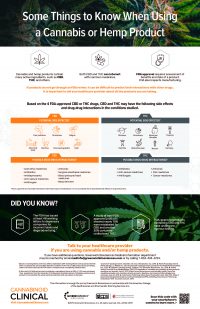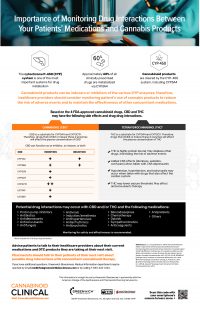Glossary
Cannabis-Related Terms
- Cannabis is a widely distributed plant¹ that is one of the oldest sources of fiber, food, oil, and medicine²
- Cannabis, and all of its cannabinoid components, is a controlled substance classified as a Schedule I agent in the US; this classification denotes a drug with a high potential for abuse and no currently accepted medical use³
The scientific name of the cannabis plant4
The two varieties of cannabis – sativa and indica – are considered subspecies; Cannabis sativa subsp. sativa contains <0.3% (dry weight) of THC and Cannabis sativa subsp. indica contains >0.3% of THC.4,5 Current botanical thinking, however, now refers only to a single species – Cannabis sativa L.
Endocannabinoid System and Related Terms
This term originates in endocannabinoid science, but is commonly used to suggest that combining multiple constituents of the whole cannabis plant may result in enhanced therapeutic effects. More data in patients are needed to support or refute this theory
in specific disease states.13,23
Why is this term considered ambiguous? Although the observation of synergy may suggest that adequate efficacy requires a cumulative effect of multiple cannabis constituents, additional testing needs to be done. Preclinical and clinical evidence suggests that some purified cannabinoids are efficacious when administered alone.13
Nutraceuticals & Dietary Supplements
A term derived from combining “nutrition” and “pharmaceutical;” there is no regulatory definition and it does not fall within a recognized regulatory category of the FDA32,33
- Individual nutraceuticals do not undergo testing for medical or health benefits
A product (other than tobacco) intended for ingestion to add further nutritional value to supplement the diet that contains one or more of the following dietary ingredients (or a constituent/extract of these ingredients)34,35
- Vitamin
- Mineral
- Amino acid
- Concentrate
- Metabolite
- Herb or other botanical
- Substance to increase total dietary intake
Dietary supplements are FDA regulated as foods, but the FDA has stated that CBD may not be marketed as a dietary supplement.36
Cannabinoids
Term used to refer to molecules that are found in the cannabis plant and/or that interact with cannabinoid receptors, as well as the derivatives, and transformation products of those molecules.6-9 They can be classified as phytocannabinoids, endocannabinoids, or synthetic cannabinoids.
Chemicals produced by the body10 that target cannabinoid receptors11
Cannabinoids produced in the laboratory to structurally or functionally mimic the endocannabinoids or phytocannabinoids10
Over 100 naturally occurring chemicals found in the cannabis plant with a chemical structure related to endocannabinoids.10
The most well-characterized, so far, are described below12:
- CBD: Cannabidiol, one of the major cannabinoids derived from cannabis or synthesized. CBD is under evaluation for
its anticonvulsant properties, among other therapeutic uses. CBD has very low affinity at the cannabinoid receptors, type 1 (CB1) and type 2 (CB2), and is not believed to be psychoactive.13 - THC: Δ9-Tetrahydrocannabinol, a major phytocannabinoid derived from cannabis, is thought to be the pharmacologically most active cannabinoid of the cannabis plant, largely responsible for its psychoactive properties due to its agonist activity at CB1 receptors (behavioral, cognitive, and psychotropic effects)13
- CBDV: Cannabidivarin, a variant of CBD with some animal evidence supporting anticonvulsant and other effects under investigation14
- THCV: Tetrahydrocannabidivarin – structurally similar to THC, it is an antagonist at CB115
- THCA: Δ1-Tetrahydrocannabinolic acid, the most abundant cannabinoid in cannabis bred for recreational use; as a nonpsychoactive precursor of THC, THCA converts to THC when heated (to temperatures greater than those found in the human body) or smoked11
Preparations from cannabis plants that are higher in CBD than plants bred historically for recreation.18
The term “enriched” is often used inappropriately.
Controlled CBD preparation that meets Food and Drug Administration standards of purity, consistency, stability, safety, and efficacy; it can be plant-derived or synthetic.19
Marijuana and Related Terms
A dried mixture of cannabis leaves and flowers12
Concept implying that products derived from the entire cannabis plant may be better than the individual cannabinoids isolated from it (eg, purified CBD-only formulas)13
euphoria, relaxation, and to enhance sociability24
†The DEA also recently affirmed maintaining marijuana as a Schedule I substance.25
‡ The Controlled Substances Act does not define hemp, per se. Its definition of marijuana includes all parts of the Cannabis sativa L. plant, and the seeds and resin extracted from any part of such plant; it exempts all marijuana stalk, fiber, and sterilized seeds (and preparations made from them).28
An extract obtained from the flowering portions of the hemp plant, then dissolved in another oil (coconut, sesame, etc). It typically contains no THC and has no psychoactive properties.29
Concentrated cannabis extracts, often containing very high concentrations of THC30,31
Why is this term considered ambiguous? The constituents are often unclear; the relative amounts of cannabinoids are not always specified.
Regulatory Guidelines§
A designation granted by the Center for Drug Evaluation and Research after rigorous placebo-controlled studies to guide correct dosing, safety, and efficacy of new compounds for medical use. 37 Demonstration of product consistency is also required for FDA approval.
Drugs, substances, and certain chemicals used to make drugs are classified into five distinct categories|| (or schedules) at the federal level by the DEA; these depend upon the drug’s acceptable medical use in treatment in the US, their relative abuse potential, and the likelihood of causing dependence when abused 38.
||Schedule 1 is the most restrictive designation.
Resources
FDA Public Hearing, May 31, 2019: Scientific Data and Information about Products Containing Cannabis or Cannabis-Derived Compounds
Webcast Recordings Now Available
A webcast recording of the public hearing is available in four distinct segments. The purpose of the public hearing was to obtain scientific data and information about the safety, manufacturing, product quality, marketing, labeling, and sale of products containing cannabis or cannabis-derived compounds.
Each segment is in order based on the agenda. You must allow Adobe Connect or Adobe Flash to run on the site to view the segments below.
- Opening until morning break
- After morning break until lunch
- After lunch until afternoon break
- After afternoon break until closing
For access to the public docket and comments, click here
Articles
Other Resources
Webinars
This website is supported by a grant from Greenwich Biosciences.



